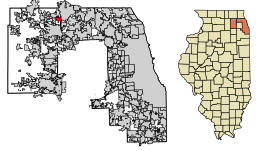East Dundee, Illinois facts for kids
Quick facts for kids
East Dundee, Illinois
|
|||
|---|---|---|---|
|
Village
|
|||
|
|||

Location of East Dundee in Kane County and Cook County, Illinois.
|
|||
| Country | United States | ||
| State | Illinois | ||
| Counties | Kane, Cook | ||
| Township | Dundee, Barrington | ||
| Incorporated | 1871 | ||
| Government | |||
| • Type | President-trustee | ||
| Area | |||
| • Total | 3.15 sq mi (8.17 km2) | ||
| • Land | 2.91 sq mi (7.54 km2) | ||
| • Water | 0.24 sq mi (0.63 km2) 8.08% | ||
| Elevation | 830 ft (250 m) | ||
| Population
(2020)
|
|||
| • Total | 3,152 | ||
| • Density | 1,082.05/sq mi (417.81/km2) | ||
| Standard of living (2007-11) | |||
| • Per capita income | $33,507 | ||
| • Median home value | $209,400 | ||
| ZIP code |
60118
|
||
| Area code(s) | 847 & 224 | ||
| Geocode | 17-21696 | ||
| FIPS code | 17-21696 | ||
| GNIS feature ID | 2398774 | ||
East Dundee is a village in Kane County with a small section in Cook County. The population was 3,152 at the 2020 census.
Geography
According to the 2021 census gazetteer files, East Dundee has a total area of 3.15 square miles (8.16 km2), of which 2.91 square miles (7.54 km2) (or 92.36%) is land and 0.24 square miles (0.62 km2) (or 7.64%) is water.
Demographics
| Historical population | |||
|---|---|---|---|
| Census | Pop. | %± | |
| 1880 | 849 | — | |
| 1890 | 1,150 | 35.5% | |
| 1900 | 1,417 | 23.2% | |
| 1910 | 1,405 | −0.8% | |
| 1920 | 1,303 | −7.3% | |
| 1930 | 1,341 | 2.9% | |
| 1940 | 1,306 | −2.6% | |
| 1950 | 1,466 | 12.3% | |
| 1960 | 2,221 | 51.5% | |
| 1970 | 2,920 | 31.5% | |
| 1980 | 2,618 | −10.3% | |
| 1990 | 2,721 | 3.9% | |
| 2000 | 2,955 | 8.6% | |
| 2010 | 2,860 | −3.2% | |
| 2020 | 3,152 | 10.2% | |
| U.S. Decennial Census 2010 2020 |
|||
| Race / Ethnicity (NH = Non-Hispanic) | Pop 2000 | Pop 2010 | Pop 2020 | % 2000 | % 2010 | % 2020 |
|---|---|---|---|---|---|---|
| White alone (NH) | 2,725 | 2,471 | 2,241 | 92.22% | 86.40% | 71.10% |
| Black or African American alone (NH) | 29 | 57 | 177 | 0.98% | 1.99% | 5.62% |
| Native American or Alaska Native alone (NH) | 3 | 3 | 0 | 0.10% | 0.10% | 0.00% |
| Asian alone (NH) | 51 | 76 | 74 | 1.73% | 2.66% | 2.35% |
| Pacific Islander alone (NH) | 0 | 0 | 0 | 0.00% | 0.00% | 0.00% |
| Other race alone (NH) | 1 | 0 | 4 | 0.03% | 0.00% | 0.13% |
| Mixed race or Multiracial (NH) | 30 | 27 | 86 | 1.02% | 0.94% | 2.73% |
| Hispanic or Latino (any race) | 116 | 226 | 570 | 3.93% | 7.90% | 18.08% |
| Total | 2,955 | 2,860 | 3,152 | 100.00% | 100.00% | 100.00% |
As of the 2020 census there were 3,152 people, 1,453 households, and 850 families residing in the village. The population density was 999.37 inhabitants per square mile (385.86/km2). There were 1,502 housing units at an average density of 476.22 per square mile (183.87/km2). The racial makeup of the village was 74.08% White, 5.84% African American, 0.54% Native American, 2.44% Asian, 0.00% Pacific Islander, 7.93% from other races, and 9.17% from two or more races. Hispanic or Latino of any race were 18.08% of the population.
There were 1,453 households, out of which 18.8% had children under the age of 18 living with them, 42.46% were married couples living together, 9.57% had a female householder with no husband present, and 41.50% were non-families. 36.75% of all households were made up of individuals, and 26.98% had someone living alone who was 65 years of age or older. The average household size was 2.91 and the average family size was 2.21.
The village's age distribution consisted of 13.8% under the age of 18, 6.6% from 18 to 24, 23.4% from 25 to 44, 29.3% from 45 to 64, and 26.9% who were 65 years of age or older. The median age was 52.0 years. For every 100 females, there were 88.8 males. For every 100 females age 18 and over, there were 77.2 males.
The median income for a household in the village was $73,199, and the median income for a family was $91,591. Males had a median income of $64,575 versus $33,723 for females. The per capita income for the village was $52,929. About 7.5% of families and 10.4% of the population were below the poverty line, including 21.5% of those under age 18 and 8.6% of those age 65 or over.
History
The village of East Dundee was incorporated in 1871, four years after West Dundee. A historic district along the Fox River and stores on Main Street constitute the commercial part of East Dundee. The historic feed and coal store became Dundee Lumber, which burned down in March 2007. A former railroad bed is now the Fox River Trail, which follows the east side of the Fox River through town. The train depot was rebuilt in 1984 as a tourist center. Santa's Village theme park operated from 1959 to 2006. It reopened in 2011 under new ownership as Santa's Village AZoosment Park.
DeLoris Doederlein, educator and politician, lived in East Dundee.
Transportation
Pace provides bus service on Routes 543 and 803 connecting East Dundee to Elgin and other destinations.
East Dundee was served by the Chicago & North Western line between Elgin and Crystal Lake. It was abandoned in the 1980s.
Notable residents
- Nina Armagno (born 1966), first female general officer of the United States Space Force. She was a childhood resident of East Dundee.
- DeLoris Doederlein (born 1925), member of the Illinois House of Representatives from 1987 to 1993. She is a longtime East Dundee resident.
See also
 In Spanish: East Dundee para niños
In Spanish: East Dundee para niños



